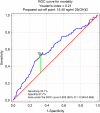Association of serum vitamin D concentration with the final course of hospitalization in patients with COVID-19
- PMID: 37727794
- PMCID: PMC10505823
- DOI: 10.3389/fimmu.2023.1231813
Association of serum vitamin D concentration with the final course of hospitalization in patients with COVID-19
Abstract
Background: Vitamin D deficiency is a substantial public health problem. The present study evaluated the association between vitamin D concentration and hospitalization and mortality risk in patients with coronavirus disease 19 (COVID-19).
Methods: This study used the COronavirus in LOwer Silesia (COLOS) dataset collected between February 2020 and June 2021. The medical records of 474 patients with confirmed severe acute respiratory syndrome 2 (SARS-CoV-2) infection, and whose vitamin D concentration was measured, were analyzed.
Results: We determined a significant difference in vitamin D concentration between discharged patients and those who died during hospitalization (p = 0.0096). We also found an effect of vitamin D concentration on the risk of death in patients hospitalized due to COVID-19. As vitamin D concentration increased, the odds ratio (OR) for death slightly decreased (OR = 0.978; 95% confidence interval [CI] = 0.540-0.669). The vitamin D concentration cutoff point was 15.40 ng/ml. In addition, patients with COVID-19 and serum 25-hydroxyvitamin D (25(OH)D) concentrations < 30 ng/ml had a lower survival rate than those with serum 25(OH)D ≥ 30 ng/ml (log-rank test p = 0.0018). Moreover, a Cox regression model showed that patients with an estimated glomerular filtration rate (eGFR) ≥ 60 ml/min/1.73 m2 and higher vitamin D concentrations had a 2.8% reduced risk of mortality (hazard ratio HR = 0.972; CI = 0.95-0,99; p = 0.0097).
Conclusions: The results indicate an association between 25(OH)D levels in patients with COVID-19 and the final course of hospitalization and risk of death.
Keywords: COVID-19; SARS-CoV-2; mortality; public health; vitamin D; vitamin D deficiency.
Copyright © 2023 Konikowska, Kiliś-Pstrusińska, Matera-Witkiewicz, Kujawa, Adamik, Doroszko, Kaliszewski, Pomorski, Protasiewicz, Sokołowski, Madziarska and Jankowska.
Conflict of interest statement
The authors declare that the research was conducted in the absence of any commercial or financial relationships that could be construed as a potential conflict of interest.
Figures





Similar articles
-
Influence of vitamin D status on hospital length of stay and prognosis in hospitalized patients with moderate to severe COVID-19: a multicenter prospective cohort study.Am J Clin Nutr. 2021 Aug 2;114(2):598-604. doi: 10.1093/ajcn/nqab151. Am J Clin Nutr. 2021. PMID: 34020451 Free PMC article.
-
Association of Vitamin D Status and COVID-19-Related Hospitalization and Mortality.J Gen Intern Med. 2022 Mar;37(4):853-861. doi: 10.1007/s11606-021-07170-0. Epub 2022 Jan 1. J Gen Intern Med. 2022. PMID: 34981368 Free PMC article.
-
Low Vitamin D Status at Admission as a Risk Factor for Poor Survival in Hospitalized Patients With COVID-19: An Italian Retrospective Study.J Am Nutr Assoc. 2022 Mar-Apr;41(3):250-265. doi: 10.1080/07315724.2021.1877580. Epub 2021 Feb 18. J Am Nutr Assoc. 2022. PMID: 33600292 Free PMC article.
-
Vitamin D Status and SARS-CoV-2 Infection and COVID-19 Clinical Outcomes.Front Public Health. 2021 Dec 22;9:736665. doi: 10.3389/fpubh.2021.736665. eCollection 2021. Front Public Health. 2021. PMID: 35004568 Free PMC article.
-
Association of Vitamin D Status with SARS-CoV-2 Infection or COVID-19 Severity: A Systematic Review and Meta-analysis.Adv Nutr. 2021 Oct 1;12(5):1636-1658. doi: 10.1093/advances/nmab012. Adv Nutr. 2021. PMID: 33751020 Free PMC article.
Cited by
-
Vitamin D: A Nutraceutical Supplement at the Crossroad Between Respiratory Infections and COVID-19.Int J Mol Sci. 2025 Mar 12;26(6):2550. doi: 10.3390/ijms26062550. Int J Mol Sci. 2025. PMID: 40141190 Free PMC article. Review.
-
Effect of Vitamin D in Long COVID Patients.Int J Environ Res Public Health. 2023 Nov 13;20(22):7058. doi: 10.3390/ijerph20227058. Int J Environ Res Public Health. 2023. PMID: 37998290 Free PMC article.
References
-
- Rusińska A, Płudowski P, Walczak M, Borszewska-Kornacka MK, Bossowski A, Chlebna-Sokół D, et al. . Vitamin D supplementation guidelines for general population and groups at risk of vitamin D deficiency in Poland-recommendations of the polish society of pediatric endocrinology and diabetes and the expert panel with participation of national specialist consultants and representatives of scientific societies-2018 update. Front Endocrinol (2018) 9:246. doi: 10.3389/fendo.2018.00246 - DOI - PMC - PubMed
-
- Koziarska-Rościszewska M, Rysz J, Stępień M. High prevalence of vitamin D deficiency and its association with metabolic disorders in elderly patients. Fam. Med Prim. Care Rev (2017) 19:372–6. doi: 10.5114/fmpcr.2017.70809 - DOI
MeSH terms
Substances
LinkOut - more resources
Full Text Sources
Medical
Research Materials
Miscellaneous

